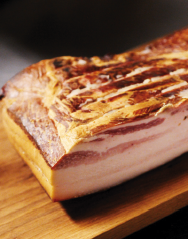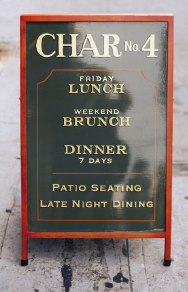CARROLL GARDENS


Whenever we dine out alone, we sit at the bar. Sometimes, if we’re feeling expansive, we’ll chat with the bartender, sometimes not. Either way, it’s a lot more fun than staring across the table at an empty chair. And in all of Brooklyn, there’s no better place to eat at the bar than Char No. 4, a sleek but inviting restaurant built on pork and brown liquor.

Start with the view. Displayed behind the bar is an eye-popping selection of whiskeys: 150 bottles of single-malt Scotches, blended Scotches, ryes, Irish whiskeys, Japanese whiskeys, Tennessee whiskeys, Canadian whiskeys, weird corn whiskeys, esoteric American whiskeys, and bourbons—above all, bourbons—glowing like caramelcoated jewels against a wall of warm yellow light. Remember that scene in Pulp Fiction when Vincent Vega opens the briefcase and its mysterious contents bathe his face in a golden glow? It’s kind of like that. Or maybe we just really like whiskey.
We like pork, too, especially smoked pork, and so does chef Matt Greco, who was sous chef at A Voce and Café Gray in Manhattan before Char No. 4 owners Michael Tsoumpas and Sean Josephs hired him to run their kitchen. (Many of the whiskeys on sale here are from Tsoumpas’s personal collection.) There’s a smoker on the premises and Greco makes full use of it, from the smoked and fried pork nuggets with hot sauce to the smoked bacon on the BLT with pickled tomatoes and chile mustard aioli to the homemade smoked stout and maple pork sausages with Brussels sprouts and bacon. Those who don’t eat pork will find a smattering of chicken, beef, and seafood dishes, but vegetarians should probably go somewhere else.
Greco was planning to move to South Carolina when he met Tsoumpas and Josephs and heard about their concept for a bourbon bar. “And I was like, ‘Wow, I love bourbon,'“ Greco says. “I’m not a wine person, I’m a beer and whiskey drinker. I’m from Texas, and that’s just what I grew up on.” They hired him in April 2008 and opened five months later.

Part of the appeal of Char No. 4— which is named for the stages of aging whiskey in charred oak barrels, the fourth stage being the highest and most intense—is that after a few visits, that whiskey list becomes a kind of challenge: Can I get through the whole thing? Anyone who tries will need some cash: Ten of these whiskeys, including the William Larue Weller 19 Year and the Macallan 14 Year Sherry Butt, cost a hundred bucks for a single ounce. But there are also about thirty whiskeys that sell for less than three dollars an ounce. Whatever your budget, Greco stands by, ready to serve up plenty of food to soak up all that booze.

This is basically New England clam chowder, so why not just call it what it is? “To be totally honest,” admits chef Matt Greco, “I thought I was making a pretty straightforward clam chowder, which I called, um, clam chowder. But I kept running into all these purists saying, ‘This isn’t chowder! It’s too thin, or it’s too thick, or it has too much bacon in it,’ or whatever. And I was like, ‘You know, I’m just trying to make a nice bowl of chowder.’ So I changed the name.” Call it whatever you want, Matt, just keep it on the menu. This is a spectacular bowl of soup—smoky and rich and perfect with a loaf of airy bread in the heart of winter.
1. Discard any clam with broken, cracked, or open shells that do not close when firmly tapped. Fill a large bowl with salted water. Add the clams and soak for 10 minutes. Drain, then scrub them with a brush to remove any remaining grit.
2. Place the clams and wine in a large pot or Dutch oven over medium-high heat. Cover and cook until the clams open, about 8 minutes. Strain the liquid through a fine-mesh strainer and reserve. Remove the clams from the shells, discarding any clams that did not open. Cut the clams in half and set aside.
3. Cut the potatoes into medium dice and place them in a bowl of cold water; set aside.
4. Cook the bacon in a large pot over medium heat until the fat is rendered, 7 or 8 minutes. Reduce the heat to low, drain the potatoes, and add them to the pot with the bacon. Stir in the leeks and salt. Cook, covered, stirring occasionally, until the potatoes are tender, about 15 minutes. Add the cream, milk, and reserved clam juice and cook for 5 minutes more. Blend 1 cup of the soup in a blender (make sure there are a good amount of potatoes in the blender). Return the pureed soup to the pot. Add the reserved chopped clams and cook until heated through. Adjust the seasonings, garnish with fresh chives, and serve.
SERVES 4
20 Littleneck clams
⅓ cup dry white wine
¾ pound purple or red new potatoes (about 5 potatoes), unpeeled
3 ounces slab bacon, cut into ½-inch dice, or 4 slices bacon, cut into ¼-inch strips
1¼ cups thinly sliced leeks, white and tender green parts
1 teaspoon coarse salt
1 cup heavy cream
1 cup whole milk
Minced fresh chives, for garnish
SERVES 4 AS A SIDE DISH
3 tablespoons pine nuts
1 cup frozen peas
3 fresh mint leaves
1 teaspoon roasted garlic paste* or 1 garlic clove, chopped
Grated zest of ½ lemon
¼ cup plus 2 tablespoons extra-virgin olive oil
Coarse salt and freshly ground black pepper
1 pound sugar snap peas, trimmed and washed
2 tablespoons finely grated Parmigiano-Reggiano, plus more for garnish
Chef Matt Greco’s grandmother is an Italian immigrant who lived most of her life on a farm in Texas. She didn’t invent this particular dish, but her cooking definitely inspired it. The pesto is a variation of a fava bean pesto Greco used to make when he worked for chef Andrew Cannellini at A Voce, the celebrated Italian restaurant in Manhattan. And the Italian theme continues with the pine nuts and Parmigiano-Reggiano (sprinkle generously), adding crunch and depth to the brightness of the snap peas.
1. Preheat the oven to 325°F. Place the pine nuts in a small ovenproof skillet and toast in the oven for 5 minutes, or until light brown. Transfer to a small bowl and allow to cool, then chop 1 tablespoon of the pine nuts. Set the chopped and whole pine nuts aside.
2. Prepare an ice bath. Bring a large pot of salted water to a boil. Add the peas and cook for 1 minute, or until tender. Using a slotted spoon, transfer the peas to the ice bath. (Keep the water boiling.) Use the slotted spoon to transfer the peas from the ice bath to a food processor. (Reserve the ice bath.)
3. To the food processor, add the mint, garlic paste or chopped garlic, lemon zest, the 2 tablespoons whole pine nuts, the ¼ cup olive oil, ¼ cup water, and salt and pepper to taste. Process until well combined but not completely smooth. Adjust the seasonings and reserve.
4. Add the snap peas to the boiling water and cook for 1 minute. Transfer to the ice bath. Drain and place in a medium bowl with the remaining 2 tablespoons olive oil, the Parmigiano-Reggiano, and the reserved chopped pine nuts. Season with salt and pepper.
5. Spread ¼ cup of the minty pea pesto on the center of each plate. Place the snap pea mixture on top. Garnish with additional grated cheese.
* To make roasted garlic paste, preheat the oven to 325°F. Cut the top off a head of garlic, wrap it in foil, and roast the garlic until golden brown, about 1½ hours. Allow the garlic to cool enough so you can handle it, then squeeze the garlic cloves out of the head and mash with a fork until it forms a smooth paste.